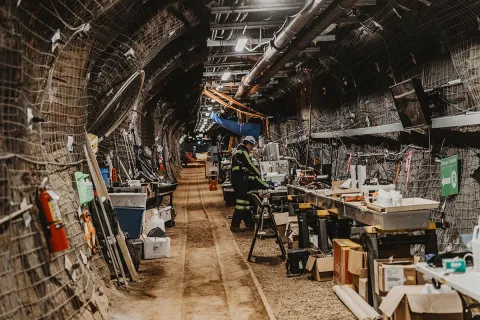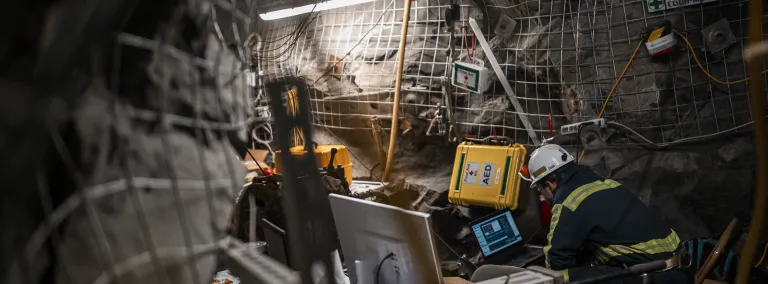Geothermal research group studies the not-so-solid ground beneath our feet
The EGS Collab will study hydraulic shearing methods, creating fracture networks to extract heat from Earth’s deep, hot rocks
Kissing the tarmac after deboarding a turbulent flight. Encouraging a friend who is prone to daydreams to return both feet to the ground. Even unconsciously pressing your heels to the floor in the midst of a heated debate. These impulses are prompted by our belief that the Earth beneath our feet is, for the most part, sturdy and immoveable, a solid place to stand.
“When you think of rock a mile underground, you think of something immobile, something solid. Kick it as hard as you can, it isn’t going anywhere,” said Tim Kneafsey, a staff earth scientist at Lawrence Berkeley National Laboratory (LBNL). “But — just as there are dozens of different kinds of rain, from a sprinkle or a drizzle to a thunderstorm — there are gradations of seismicity. Quakes in the earth aren’t always a horrible disaster. The ground is constantly being stressed, compacted and expanded in ways so small you can’t feel them, but measuring and locating the microseismicity teaches us about rock behavior.”
As principal investigator for the Enhanced Geothermal Systems Collab Project (EGS Collab), Kneafsey’s job is to scrutinize every such quiver, shift and murmur in the team’s research testbed on the 4100 Level of Sanford Underground Research Facility (Sanford Lab). These minute movements help researchers unlock the immense potential of geothermal energy.
Pathways through the rock
In an ideal geothermal system, two wells are connected by an extensive network of small fractures. This network allows water to pass from one well to another, heating up as it flows over the rock’s exposed surface area. But such extensive networks can be difficult to come by.
“Geothermal energy extraction requires three things: hot rock, permeable pathways through the rock and fluid to extract the heat,” explained Kneafsey. “Hot rock is an abundant resource in the U.S., but it is often missing open pathways that allow you to extract the heat.”
Funded by the Geothermal Technologies Office of the Department of Energy, the EGS Collab is studying how different methods of rock stimulation can open a matrix of natural fractures.

First, the team studied a method called “hydraulic fracturing.” From 2015 to 2020, researchers drilled multiple boreholes at a testbed on the 4850 Level of Sanford Lab. In several boreholes, the team injected pressurized water to stimulate the rock and open fractures. Other boreholes were instrumented with a dense array of very sensitive sensors to monitor how the rock responded to the stimulation.
Data collected on the 4850 Level gave the team a rare insight into the effects of hydraulic fracturing.
“Earth scientists never really get to put their hands around what they’re working on,” said Hunter Knox, the EGS Collab lead at Pacific Northwest National Laboratory (PNNL). “But when we put our data sources together, when we combined our lines of evidence, we saw how this testbed evolved. The data showed us how the relationships, both in time and space, are important in how these formations and fractures change over time.”
But there is another, potentially more efficient way to stimulate rock for geothermal systems. This method, called “hydraulic shearing,” attempts to move the surfaces of the rock laterally, creating permanent open pathways.
“By opening existing fractures and causing them to shift laterally, the roughness of the fractures keeps them propped open,” Kneafsey said. “This self-propping allows water to flow through and, in hot rock environments, transfer heat.”
On the 4100 Level of Sanford Lab, an EGS Collab testbed will be dedicated to exploring hydraulic shearing techniques.
A model of the Sanford Lab underground with the conceptual designs of EGS Collab testbeds. This model was built and animated by Pengcheng Fu, research scientist at Lawrence Livermore National Laboratory (LLNL). Data for facility levels and testbed designs were provided by William Roggenthen, research scientist at South Dakota School of Mines and Technology, and Joseph Morris, associate program leader at LLNL, respectively. " data-entity-type="media" data-entity-uuid="4f710b02-c780-4d0b-968f-f87eaba79aa8">
Several researchers, including Kneafsey and Knox, are currently unable to travel to Sanford Lab due to travel restrictions related to COVID-19. Still, the project has been able to move forward with the help of local and regional contractors.
In February 2021, DA Smith Drilling Company began drilling the new testbed’s nine boreholes, five for injecting or receiving water and four for monitoring the responses in the rock. RESPEC, an engineering firm headquartered in Rapid City, is aiding the research group by making detailed measurements in the new boreholes to help understand the rock and helping with core evaluation.
Supporting Utah FORGE
The data and knowledge collected from EGS Collab’s investigation will be applied at the Frontier Observatory for Research in Geothermal Energy, known as Utah FORGE. A flagship DOE geothermal project, Utah FORGE is kilometer-scale field laboratory in Milford, Utah — a full-scale analog to the ten meter-scale EGS Collab testbeds at Sanford Lab.
“There remains an uncertainty in terms of the best way to communicate between two wells,” said John McLennan, a co-principal investigator for Utah FORGE from the University of Utah and liaison to EGS Collab. “We are fairly certain that the methodology should enfranchise natural fractures, but what exactly should that method be? The industry is still not 100 percent certain.”
At Utah FORGE, research groups develop technologies needed to create large-scale, economically sustainable heat exchange systems, thus paving the way for a reproducible approach that will reduce risks associated with EGS development with a goal of powering 10 million homes.
A drill rig at the Utah FORGE geothermal research field laboratory. The Utah FORGE site is located near the town of Milford in Beaver County, Utah, on the western flank of the Mineral Mountains. Photo by Eric Larson" data-entity-type="media" data-entity-uuid="ba652231-9603-4ccf-b6b7-772debf3a6ac" src="/sites/default/files/inline-images/Drill%202.jpg">
“The upcoming EGS Collab experimentation on the 4100 Level, to me, is one of the most interesting elements that will have direct relevance to our future stimulation activities at Utah FORGE,” McLennan said.
Livestreaming science
In addition to providing data for Utah FORGE, the EGS Collab’s research has reached international audiences. In 2017, the EGS Collab began to livestream their test runs.
“We’ve never held a closed meeting,” Kneafsey said. “We don't want this to be a closed project. Oftentimes, experimentalists go into the field, do our experiment, and come back with a ream of data. You hand it to an analyst and say, ‘Figure this out.’ But, in the case of EGS Collab, experimentalists and numerical modelers are working hand-in-hand during the experiment to try to figure things out, and it really improves the product.”
Paul Schwering, senior geoscientist at Sandia National Laboratories (SNL), recalled one livestream that lasted 30 days. Throughout the extended test run, experts from laboratories, universities and commercial interest groups around the globe checked in to share their expertise.
“I'd call it a renaissance of underground laboratory work in hard rock,” Schwering said. “Being able to cross-pollinate, to share lessons learned and to have that open communication has brought together a worldwide network of incredible scientists who are working on solving these challenges.”
When EGS Collab begins testing hydraulic shearing techniques on the 4100 Level, the team will continue to broadcast their tests, drawing on insight from this international community to propel geothermal research.
The EGS Collab has previously been referred to as SIGMA-V at Sanford Lab.
The EGS Collab project includes researchers from ten national labs — Lawrence Berkeley National Laboratory, Sandia National Laboratories, Pacific Northwest National Laboratory, Lawrence Livermore National Laboratory, Idaho National Laboratory, Los Alamos National Laboratory, National Energy Research Laboratory, Oak Ridge National Laboratory, National Energy Technology Laboratory, and Brookhaven National Laboratory; and eight universities — South Dakota School of Mines and Technology, Stanford, University of Wisconsin, University of Oklahoma, Colorado School of Mines, Penn State, Rice University, and Texas A&M University. Many industry consultants and contractors, as well as the incredible team at Sanford Lab, continue to be instrumental to the ongoing success of the project.
